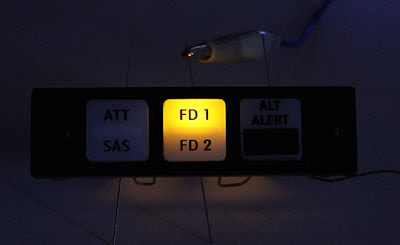As the final post dealing with the various parts we've been designing for a BK-117 helicopter simulator, this component is by far the largest single piece although was relatively painless to manufacture (panel-wise) due its being based around our standard 30x10 annunciators. Aside from making the appropriate surround to fit our client's dimensions, it was really just a matter of customising the legends as necessary.
There are terminals for a 'Lamp Test' button to be connected, and in
the photo above you can see that it has been connected and pressed!
the photo above you can see that it has been connected and pressed!
[Here's a shot of the original layout our panel was based on.
The legends differ in places due to each Caution Panel
reflecting a slightly different configuration.]
Cold and dead.
The LED boards that are shown fitted to the rear of the panel are actually truncated versions of those that are typically used in our King Air MIP Annunciator Panels. The matrix for those units are 6 x 6 whereas here we needed to use a 5 x 5 matrix. Designing the PCB layout (so that the PCBs can be readily used for either variation) was an interesting process and the most time-consuming for this particular piece of hardware.
The cables and PCBs will eventually be interfaced via our Conditional 64 Outputs Board, which uses RJ45 connections. Note, however, that headers are also fitted so that it can be interfaced in another way if desired.





.jpg)
.jpg)
.jpg)
.jpg)

.jpg)




.jpg)

.jpg)
.jpg)
.jpg)
